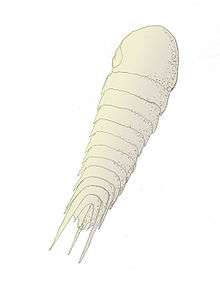Acanthomeridion
Acanthomeridion is an extinct arthropod found in the Chengjiang fauna deposits of China.[2] In 1997, it was placed in its own, monotypic family, Acanthomeridiidae.[3] It is known from eight specimens, all found in China.[4]
| Acanthomeridion | |
|---|---|
 | |
| Scientific classification | |
| Kingdom: | |
| Phylum: | |
| Class: | |
| Family: | Acanthomeridiidae Hou & Bergström, 1997 |
| Genus: | Acanthomeridion Hou, Chen & Lu, 1989 |
| Type species | |
| Acanthomeridion serratum Hou, Chen & Lu, 1989 | |
| Other species | |
|
Acanthomeridion anacanthus | |
Morphology
Acanthomeridion was a 35 mm-long animal, with 11 segments ending in rear-facing spines. The head features free cheeks separated from the rest of the head by sutures. This is analogous with trilobites. Otherwise, affinities are mainly unclear.[4] More recently discovered specimens of the species Acanthomeridion anacanthus have paired gut diverticula as have been seen in artiopods.[5] No fossils exposing the limbs have yet been found, but they are thought to be biramous with the upper section of the limb holding the gills. As limbs have not been found, it is uncertain whether Acanthomeridion was a seafloor-dweller or a swimmer. The streamlining suggests that it swam, but is inconclusive.
Taxonomy
Acanthomeridion is considered a primitive member of Artiopoda. Some studies have put it as having affinities with petalopleurans or xandarellids, but a more recent study by Hou, Williams et al. including the more recently discovered specimens suggest that it is the most basal member of the clade.[5]
References
- Xianguang Hou; Mark Williams; Sarah Gabbott; David J. Siveter; Derek J. Siveter; Peiyun Cong; Xiaoya Ma; Robert Sansom (2016). "A new species of the artiopodan arthropod Acanthomeridion from the lower Cambrian Chengjiang Lagerstätte, China, and the phylogenetic significance of the genus". Journal of Systematic Palaeontology. 15 (9): 733–740. doi:10.1080/14772019.2016.1229695. hdl:2381/41202.
- X.-G. Hou, J.-Y. Chen & H.-Z. Lu (1989). "Early Cambrian new arthropods from Chengjiang, Yunnan". Acta Palaeontologica Sinica. 28: 42–57.
- J. Bergstrom & X. Hou (1997). Arthropods of the Lower Cambrian Chengjiang Fauna, Southwest China. Fossils and Strata 45. Wiley-Blackwell. ISBN 978-82-00-37693-4.
- Xiang-Hong Feng, Xian-guang Hou (2008). The Cambrian Fossils of Chengjiang, China: The Flowering of Early Animal Life. John Wiley & Sons. p. 176.
- Hou; Williams; Gabbott; Siveter; Siveter; Cong (2017). "A new species of Acanthomeridion". Journal of Systematic Palaeontology. 15 (9): 733–740. doi:10.1080/14772019.2016.1229695. hdl:2381/41202.